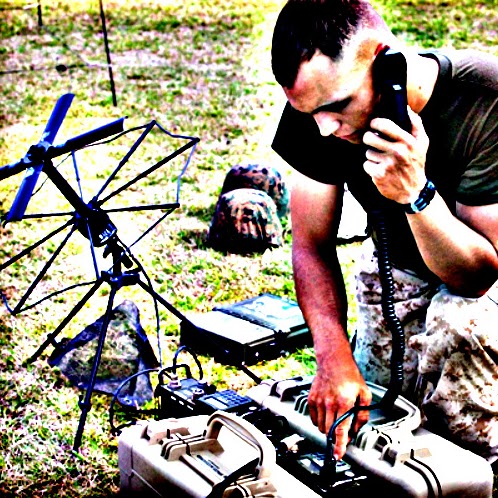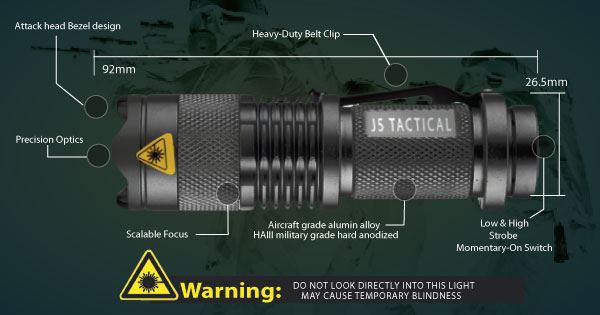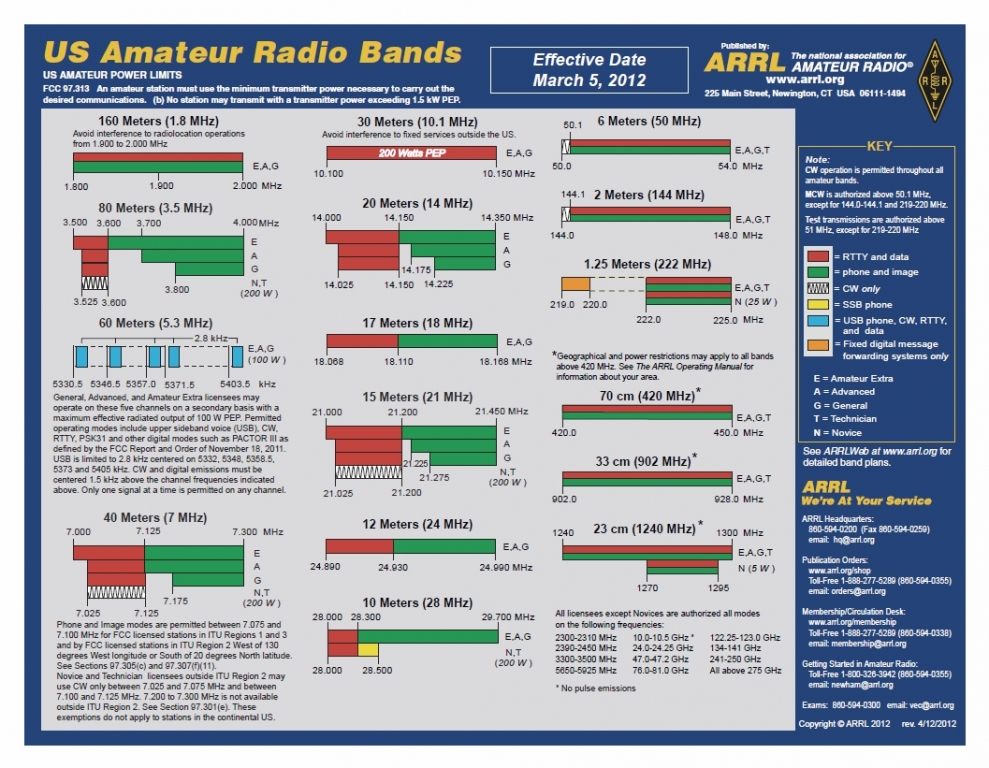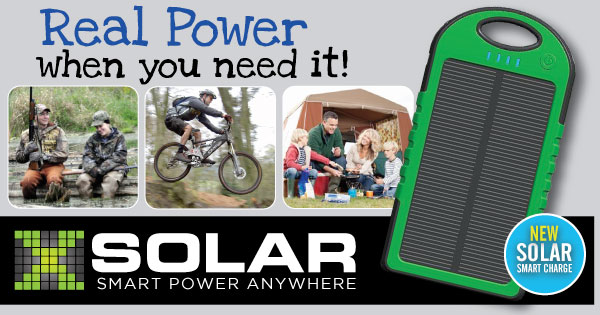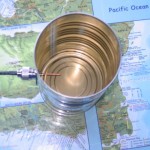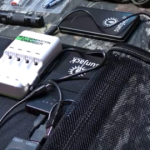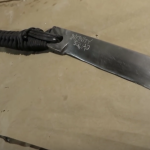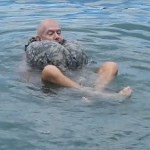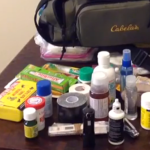So how would you communicate with your family or get help if communications go down?
So if you found yourself in the middle of a wide-scale disaster such as a hurricane or other catastrophe and you had no government coming to help for a while, how would you communicate with your family or others? What if the power grid went down?
You won’t be able to rely on your cell phone. There are alternatives, however.
I’ll go over the basics of some emergency communication methods but if you want more detail, check out Personal Emergency Communications: Staying in Touch Post-Disaster: Technology, Gear and Planning.
Short-term emergencies have shown the limitations of using cell phones to coordinate with each other. Even if the towers are operational, they can’t handle the added traffic of millions of people trying to get a hold of loved ones – or help. Ever had trouble calling your mother on the morning of Mother’s Day?
During many recent events, cell phone service wasn’t an option for many for days. The system became seriously overloaded on 9/11 so calls wouldn’t go through, 70% of the towers went down during Katrina and were down for days, and most areas haven’t been adequately improved across the US.
These won’t be isolated events. Don’t think that because you live in a large metropolitan area that you’re safer. A quick look at some of the things that went on during Hurricane Sandy in NY will show that the government has a lot to deal with in addition to just trying to get your cell phone service back up so even though that was a pretty short-term event, it caused a lot of problems.
Here are just a few issues that would affect you being able to pull out your iPhone to call up people:
- Cell phone communication has a lot of vulnerabilities that make it a poor solution for widespread or long-term emergencies.
- Heavy winds or flooding can disrupt the cables between towers such as during Hurricane Sandy.
- Cell towers require AC power to operate so if they don’t have an automatic backup system, they stop. Keep in mind that a lot of towers are just glorified antennas on the tops of buildings or mountains and backup power, such as an emergency generator, is a very short-term solution. Generators require fuel and that fuel has to be replenished quite often. In a lot of cases, the only backup power available is a bank of batteries that stop charging when the main power system stops.
- Backhaul systems (essentially the system that connects and/or allows overflow from outer systems to the core, often including other carriers) aren’t always reliable. A lot of this system is wired but has been expanded to microwave and other systems.
- Most cell phones will only stay charged for a day or three. If you don’t have local power to keep it up, when the system does come back up, you won’t be able to talk to it.
- Cell phones require satellites, which are vulnerable to hackers, physical attack, or solar storms.
Now don’t get me wrong, for day-to-day emergencies, such as getting a flat tire, a cell phone usually works pretty well. It’s just a crappy solution for big emergencies. They’ll be pretty useless if the national grid goes down due to a cyber attack, EMP or CME, which is actually a lot more likely than you might think.
One cool idea that’s coming out is the goTenna cell phone radio antenna system. Your cell phone connects to it via Bluetooth and an app, and the signal is sent and received through an encrypted radio signal. How awesome is that? It won’t be able to reach to the other side of a city but you should be able to locate your family if they’re in the area and maybe even communicate with others if they have the system.
So if you can’t rely on cell phone service, what other options do you have?
CB radio for emergency comms
A lot of people grew up watching BJ and the Bear and they remember seeing all the truckers talking over the air with each other. CB radio is definitely more available during an emergency but they have a lot of limitations.
For one, not a lot of people are on CB. You might be able to find someone in a truck but even that’s harder to find. The problem isn’t just the lack of people who use it, it’s the lack of people in your range that use it.
One of the big reasons your range is very limited with CB vs other systems is that they’re limited to 5 watts input which is about 4 watt out. That may be just some vague notion but more power means more distance. At the frequencies that CB radios use, you can only expect to get between 1 and 10 miles or so, depending on the terrain. There could be a million people in the US with their CB’s all on the same channel at the same time, but if they’re not within range, you won’t be talking.
You might think that you could just hack into your ham radio and pump out more power, but the FCC goes after people who do that (just a few examples). Obviously if SHTF, you’re not gonna really care about that but remember that adding more power to transmit and receive farther doesn’t do anything to help you hear the other guy with a normal CB transmitter.
How good are satellite phones in an emergency?
For a lot of emergency situations, satellite phones are pretty good. The first problem with them though is cost. They’re mighty expensive. Not only do you have to shell out for the phone, you have to pay for service and minutes. If you’re stranded somewhere though, it may be worth the cost.
They don’t always work though. I had one with me at all times when I was in Uganda, and it came in hella handy at times. They don’t like jungles though due to the trees blocking the satellites and contrary to what every freaking movie shows, they don’t work indoors or inside a ship like they kept showing in World War Z (which was a decent movie but movie mistakes like that drive me crazy).
The real problem is that it’s highly unlikely you’d need it in a normal household so they’re ONLY good for emergencies and probably not worth the cost.
Another big problem is that just like cell phones, they rely on the satellites to function so if the satellites stop working, then so do the satellite phones. Obviously. Solar storms and CMEs have taken out satellites in the past. They will do it again.
GMRS/FRS/MURS radios
For local communication, GMRS, FRS and MURS radios are pretty good. They don’t require an FCC license for FRS and MURS, they’re cheap, and easy to use. They’ve pretty much replaced CB radios for a lot of families. As such, even though they’re an improvement, they have a lot of the same limitation on power and range.
If you have a true GMRS radio, you may be able to tap into a repeater, which will expand your range to possibly hundreds of miles, but the repeater obviously has to be running, and you have to be within range of the repeater for your radio to hit it. GMRS radios are also allowed to operate at higher power than a lot of other radios. You also need a license to use GMRS frequencies.
Basically, if you’re considering one of these radio systems for emergency use, go with a true GMRS radio and get the license.
Amateur radio (ham radio): the best emergency communication system
So now that I’ve gone through several options that you could choose, but obviously from the title I don’t recommend, let’s look at ham radio.
Ham radio is the go-to communication system for pretty much every emergency response system and is what MARS (the Military Auxiliary Radio System) and ARES (Amateur Radio Emergency Service) both use, as well as many search and rescue and other emergency groups.
One of the nice things is that a lot of ham radios can reach the national weather system (NOAA) frequencies. That means that if you have a radio, you can find out what’s going on in the area. If you have a radio scanner, you can listen to what’s going on with emergency frequencies as well as any other that the scanner can reach, and you don’t have to know which one they’re transmitting on. That’s why they call it a scanner. It goes in a loop up through whatever frequencies you tell it to and it stops if it hears someone transmitting.
Here is a list of amateur radio emergency frequencies that you should keep in mind when both looking for radios and coming up with your emergency communications plan:
34.90: Used nationwide by the National Guard during emergencies.
39.46: Used for inter-department emergency communications by local and state police forces.
47.42: Used across the United States by the Red Cross for relief operations.
52.525: Calling frequency used by ham radio operators in FM on their six-meter band.
121.50: International aeronautical emergency frequency.
138.225: Disaster relief operations channel used by the Federal Emergency Management Agency; it is active during earthquakes, hurricanes, floods, and other catastrophic events.
146.52: Used by ham radio operators for non-repeater communications on the two-meter band; it is very busy in many parts of the country.
151.625: Used by “itinerant” businesses, or those that travel about the country. Circuses, exhibitions, trade shows, and sports teams are some of the users you can hear. Other widely used itinerant channels are 154.57 and 154.60.
154.28: Used for inter-department emergency communications by local fire departments; 154.265 and 154.295 also used.
155.160: Used for inter-department emergency communications by local and state agencies during search and rescue operations.
155.475: Used for inter-department emergency communications by local and state police forces.
156.75: Used internationally for broadcasts of maritime weather alerts.
156.80: International maritime distress, calling, and safety channel. All ships must monitor this frequency while at sea. It is also heavily used on rivers, lakes, etc.
162.40: NOAA weather broadcasts and bulletins.
162.425: NOAA weather broadcasts and bulletins.
162.45: NOAA weather broadcasts and bulletins.
162.475: NOAA weather broadcasts and bulletins.
162.50: NOAA weather broadcasts and bulletins.
162.525: NOAA weather broadcasts and bulletins.
162.55: NOAA weather broadcasts and bulletins.
163.275: NOAA weather broadcasts and bulletins.
163.4875: Used nationwide by the National Guard during emergencies.
163.5125: The national disaster preparedness frequency used jointly by the armed forces.
164.50: National communications channel for the Department of Housing and Urban Development.
168.55: National channel used by civilian agencies of the federal government for communications during emergencies and disasters.
243.00: Used during military aviation emergencies.
259.70: Used by the Space Shuttle during re-entry and landing.
296.80: Used by the Space Shuttle during re-entry and landing.
311.00: Flight channel used by the U.S. Air Force.
317.70: Used by U.S. Coast Guard aviation.
317.80: Used by U.S. Coast Guard aviation.
319.40: Used by the U.S. Air Force.
340.20: Used by U.S. Navy aviators.
409.20: National communications channel for the Interstate Commerce Commission.
409.625: National communications channel for the Department of State.
462.675: Used for emergency communications and traveler assistance in the General Mobile Radio Service.
Here is a large list of different frequencies that you could use to put together a list of channels to follow during an emergency or other times.
Ham radio operation requires a license, but they’re easy to get. This isn’t quite as daunting as it seems, especially considering you don’t need to learn Morse code anymore, but it still requires some studying.
There are three main levels of licensing: Technician, General and Extra. The higher license you get, the more frequencies you can use. This is important. The lower license will get you started but you really need the higher licenses if you want to communicate around the world.
So why is it important to get a license? In non-emergency life, you have to be concerned that the FCC will go after you if you transmit on a frequency that you’re not allowed to operate. For you to be ready for a SHTF scenario, you need to have the equipment and practice with it in order to make sure you’ll be able to get through.
Just like with FCC investigators and volunteers who track down offenders (you have to call out your FCC callsign every 10 minute on the air or you’ll probably get some unwanted attention), if you find yourself in martial law and don’t want to be found, they can track you down pretty easily.
So why does it matter about what frequencies? Just like with CB radios and the others, the frequency will affect how far you can transmit/receive a signal. This can be pretty complicated so it’s best to get a good book on antennas and propagation, and work with more experienced people to help you get going.
There are a LOT of people around the world who use amateur radio. These people are typically in tune with dealing with emergencies or working with communicating with people in different scenarios. Because of the range ham radios can get, it’s a LOT easier to get a hold of someone during an emergency. These people are also extremely resourceful so even if they don’t have a working radio (such as after an EMP pulse), they can make one.
I currently have three ham radios. An inexpensive Baofeng UV-5R handheld that I keep on my Harley, a great Yaesu VX-6R waterproof handheld with an upgraded antenna that I keep in my bugout bag, and a portable Yaesu FT-857d radio that I can run off a 12v battery. I’m seriously considering upgrading to the Yaesu VX-8DR
though because it’s pretty awesome. You might prefer the VX-6R
though.
Here’s a video that shows the difference and some of the cool features, btw:
A big part of getting your signal out and hearing others is the antenna so if you get a handheld, I’d suggest upgrading the antenna like I mentioned above. Keep in mind also that if you get a Baofeng that their antenna connections are different so you’ll need an adapter in some cases.
Repeaters:
There are a lot of repeaters around the world that can help you transmit long distances with just a little radio. Basically, a repeater will listen to the little radios in its immediate surroundings and then blast the signal out for hundreds, or thousands, of miles. Obviously the repeaters need to be functioning to do this but people who have repeaters are usually up on emergency communication and will have backup power systems. If they go down, they usually know how to fix it.
There are even repeaters that use the internet so if you tap into a repeater and type in the address of a remote repeater in another country, what you say on your little radio will blast out to that point on the other side of the world.
Using stealth to operate an amateur radio:
Because ham radio people are crafty lot (and some places don’t allow antennas), there is a whole sub-genre of ways to make antennas so they can’t be detected (by sight, not by signal). Antennas can be made out of flagpoles, ladders, fences, railings, and a lot of other things in plain sight. They can also be hidden inside things or buried.
There are several books such as Low Profile Amateur Radio: Operating a Ham Station from Almost Anywhere that can show you how to do these (which is a great book, by the way but good luck finding a copy of it).
With the proper knowledge (which you can pretty much only get with practice), you can make a radio out of stuff you can find pretty much anywhere that will transmit on frequencies that you can reach other people. Not only is this useful to hide your antennas, it could seriously come in handy if you had to make an antenna in an emergency.
Obviously, the more experience you have with radios, the easier it’ll be for you to do something like this.
The Ham radio community:
As I’ve mentioned, amateur radio operators are not only creative and resourceful, they’re very in tune with handling emergency situations. There are several groups that use ham radio for dealing with disasters or for search and rescue. The two biggest are Radio Amateur Civil Emergency Service (RACES) and Amateur Radio Emergency Service (ARES).
Creative ways to communicate with ham frequencies:
With the right equipment and some practice, you can easily get around the world. And, you don’t have to actually buy a radio to do it. That’s one of the greatest things about learning and using ham radio. You can literally make a working radio out of scrap. There will always be scrap. You will always be able to make a radio.
In addition to the plethora of ham radio equipment and information available, a good basis of theory can get you talking to people even if all electricity and electronics are taken out. Here are some examples of what you can do with a little knowledge:
The Foxhole Radio
A foxhole radio was used by GI’s during WWII and beyond. The cool thing is that it doesn’t require a power source and is made from simple parts like a pencil and razor blade. It’s only a receiver though.
Crystal Radios
There are many, many, many ways to make a radio out of household items. Way too many to list them here. Suffice it to say that with all the wires and old electronics laying around, making a simple radio receiver is pretty simple. Just like the foxhole radio, these pretty much only receive. They can also be made to use power from the signal itself so they don’t all need anything else to power them.
Homemade AM transmitter?
Fear not dudes and dudettes, you can still make a transmitter out of stuff you can find in a lot of homes or junkyards:
The spark-gap transmitter
Spark-gap transmitters are pretty simple to make. The good thing is that they transmit over a HUGE frequency range so pretty much anyone nearby is gonna hear it.
The bad things are that they’re illegal (for the same reason) and can zap the heck out of you if you’re not careful. You also have to learn Morse code or create your own in order to have anyone have any idea what you’re trying to say.
If you don’t have a ham radio license yet (or actually, even if you do), you should look at getting an emergency shortwave radio so you can listen into weather bulletins etc. The Safe-T-Proof radio is a great little one to have because you can charge it with a hand crank or the solar panel, it has a flashlight and a cell phone charger outlet on it too.
It won’t have the range of a ham radio with a good antenna, but it could be really useful in an emergency, and you don’t have to worry about running out of power.
So, there are many different ways to communicate during a disaster situation or if society collapses but for the most flexible and effective way, you should seriously look into getting your ham radio license and start playing with it. It’s a great hobby and one that could be the difference between finding your family in an emergency or losing them.
Either way, make sure whatever you do that you come up with an emergency communications plan beforehand.
by


